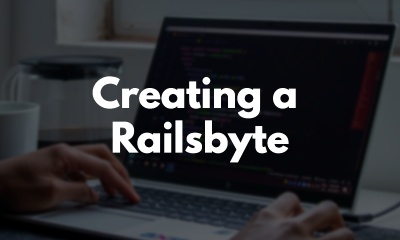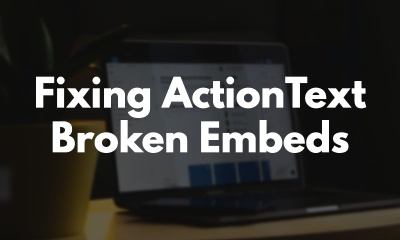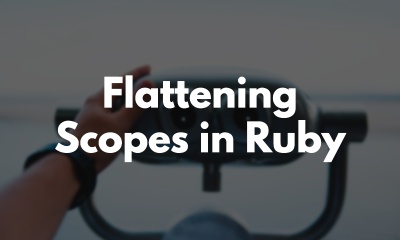Articles of interest for Ruby on Rails
Displaying articles 1 - 25 of 5374 in totalArticle Sources
-

Creating a Railsbyte
In this episode, we look at how to make a Railsbyte template. Specifically, we will be making a Railsbyte that will set up our application for deployment with Render which will allow us to be able to reuse the template on any application that we would lik
Published:
-

Error Handling Ergonomics in Noticed
Errors can come up in many different ways. This episode, we'll look at how we can improve error handling in the noticed gem to cleanly handle issues with ActiveRecord without negatively affecting
Published:
-

How to Deploy Rails to Render
Deploying your Ruby on Rails applications to Render is only a few file modifications away. Learn how to deploy your Ruby on Rails applications using Render in this episode.
Published:
-

How to build GitHub Apps with Rails
Integrating with GitHub Apps in your Rails app can seem daunting. It's a bit more complicated than just redirecting to OAuth and receiving an access token. In this episode, we'll look at a basic GitHub app integration we used for the Rails Hackathon
Published:
-

How To Maintain A Rails Gem: Becoming Maintainer of the Sequenced Gem
I recently became a maintainer of the Sequenced gem for Rails, so this lesson we walk through all the different things for maintaining a gem and making sure it works with the latest Rails versions.
Published:
-

How to Deploy Rails to Fly.io
Fly.io supports deploying Ruby on Rails using Docker containers to multiple regions. For the same benefits you get using a CDN, you can use Fly.io to deploy Rails and Postgres close to your users around the world.
Published:
-

How to use the MQTT Protocol with Ruby
MQTT is a message protocol for Internet of Things devices. It's very similar to pubsub where you can broadcast and subscribe to different topics. Learn how to send messages to an MQTT broker in this tutorial.
Published:
-

Air Quality Monitoring with Ruby, a Raspberry PI & PMS5003 Sensor
Learn how to use a PMS5003 air quality sensor with Ruby on the Raspberry Pi. We'll use this to monitor air quality and gather data.
Published:
-

How to use hCaptcha with Ruby on Rails, Turbo, and Stimulus.js
hCaptcha is a method to try detecting bots on your website. This episode, we'll walk through how to implement hCaptcha in a way that's compatible with Turbo using Stimulus.js and
Published:
-

How to Modify & Customize ActionText HTML Output in Rails
Ever needed to modify the HTML that ActionText renders? We can override the ActionText::Content class to modify the way HTML formatting works to customize the output. For example, we can add rel="noopener nofollow" to any anchor tags in the content.
Published:
-

How To Update ActionText Attachments
Rails 7 changed the way ActionText attachments work, so we'll be writing a Rake task to walk through each of the embeds and update them with the correct Signed GlobalID.
Published:
-

Rails ActionController Parameters with_defaults
Learn about the ActionController Parameters with_defaults method to clean up your params in your Rails applications
Published:
-

Custom Turbo Confirm Modals with Hotwire in Rails
Overriding the Confirm method in Turbolinks and Hotwire has been pretty tricky until now. Using promises, Turbo can now wait until the user has submitted the confirm modal.
Published:
-

Polymorphic Selects in Rails using GlobalIDs
Using Signed GlobalIDs, we can create polymorphic select boxes in Rails to easily choose a record of any type. This is also secured by using signed global IDs to prevent tampering by malicious users.
Published:
-

Eigenclasses
In this episode, we will be looking into Ruby's eigenclasses or singleton classes. We will first look at singleton methods and then how we can access the eigenclasses of objects.
Published:
-

How to add a Command Palette to your Ruby on Rails app
A command palette is a common feature for power users. Learn how to add a command palette to your Ruby on Rails app using the Ninja Keys web component.
Published:
-

Building has_one from has_many Associations
In this video, we will take a look at how to use a few association declaration options to build a couple of has_one associations off of a has_many association in Rails.
Published:
-

Domain & Subdomain Routing Constraints in Rails
Learn how to apply advanced routing constraints such as domain, subdomain, user authentication, and more. We'll explore how to use custom constraints for routing multi-tenant Rails applications based upon subdomain and domain too.
Published:
-

Testing a Meilisearch Integration with Ruby on Rails
Testing your Meilisearch integration in Rails can be a little tricky. This episode, we'll talk through how to setup Meilisearch in your test suite to index fixtures and more.
Published:
-

Concept Application: Assert Difference Deep Dive
In this video, we will explore how the concepts we looked at in "Flattening Scopes in Ruby" are used in Rails by taking a look at the assert_difference method. We will walk through how the method works while taking note of where the concepts are applied.
Published:
-

Custom Route Constraints & Regex in Rails
Learn how to use custom route constraints in Rails to customize how routes respond to URLs
Published:
-

Testing Against Multiple Databases in Rails with The DATABASE_URL Env Var
Rails apps and Rubygems might need to support multiple databases. We can use the DATABASE_URL environment variable to quickly swap out the database that Rails uses in CI, local testing, and more.
Published:
-

Flattening Scopes in Ruby
In this video, we will look at how to use blocks and bindings in Ruby to pass local variables across different scopes.
Published:
-

How to use CSS Variables with Ruby on Rails
CSS Variables or CSS custom properties allow you to define variables that can be used throughout your CSS to change properties and their values dynamically. It's a wonderful feature for allowing users to customize the look of your website.
Published:

